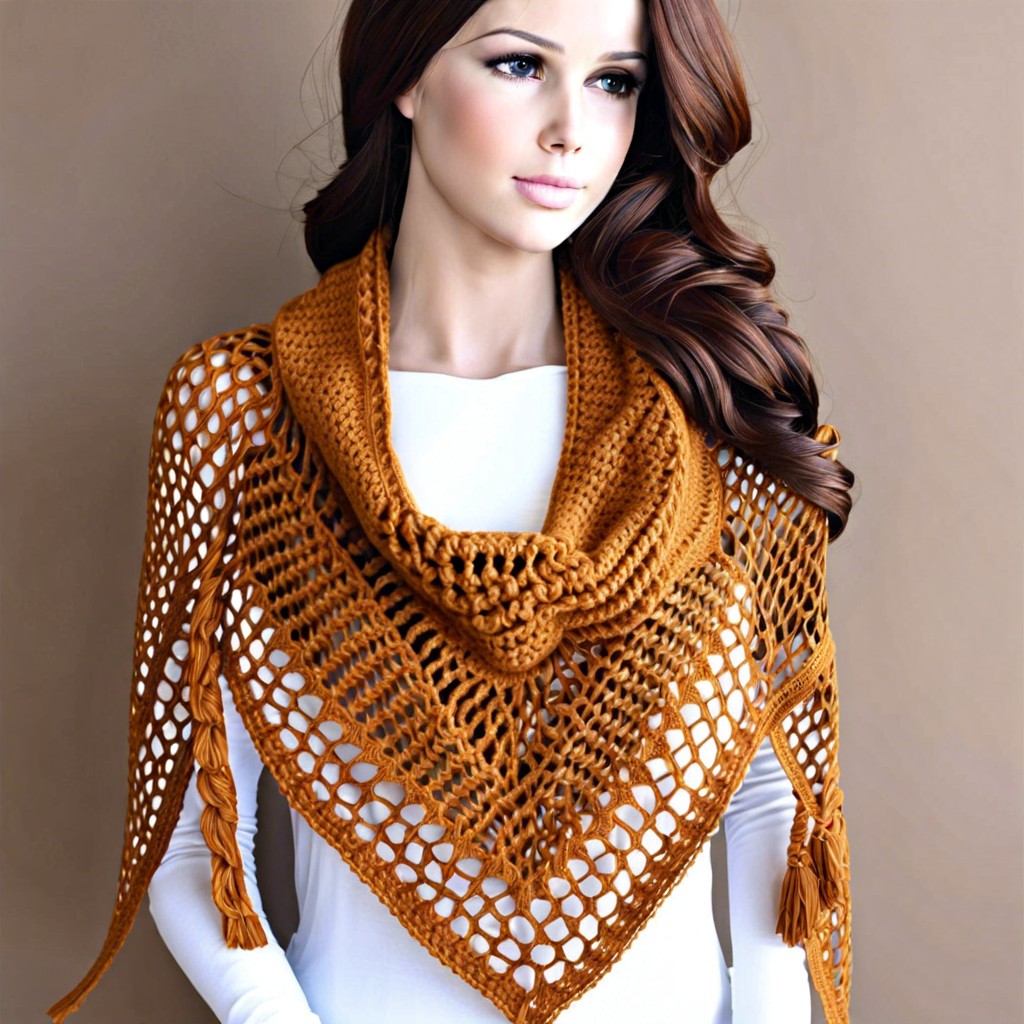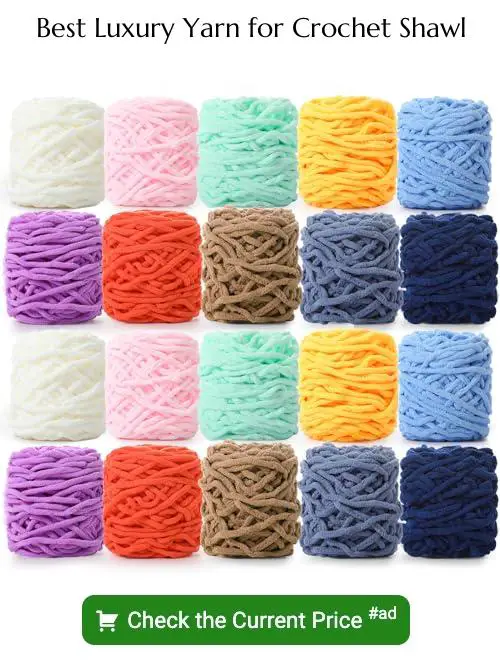Learn how to crochet a beautiful shawl with step-by-step instructions and helpful tips.
Ah, the magic of crochet shawls! Whether you’re looking to drape yourself in cozy elegance, gift a handmade treasure, or just flaunt your crochet prowess, you’ve come to the yarn-filled wonderland. From selecting just the right skein of yarn to nailing those stitch techniques without pulling your hair out — we’ve got you covered. Dive into types, patterns, customization hacks, and even how to style and care for your creation. Stick around; your crochet masterpiece awaits!
Key takeaways:
- Variety of Shawl Shapes: Triangle, Rectangle, Half-Circle, Circular, Faroese.
- Essential Supplies: Crochet hook, yarn, needle, markers, scissors, tape.
- Yarn Selection Tips: Consider season, weight, color, fiber, care instructions.
- Must-Try Patterns: Granny, Triangle, Lace, Shell, Virus shawl.
- Key Stitch Techniques: Chain, Single, Half-Double, Double, Treble crochet.
Types of Crochet Shawls

From the trendy triangle shawl to the versatile rectangular wrap, variety abounds. Triangle shawls, whether equilateral or asymmetrical, are perfect for draping over your shoulders or even wearing as a scarf. Rectangular wraps, essentially elongated scarves, are a cozy choice for those chilly evenings or long flights, doubling as a blanket—if you don’t mind looking like a chic burrito.
The half-circle shawl provides a nice compromise, offering generous coverage while still allowing for some flair. Circular shawls can be a bit more complex to craft but make you look like you’re wearing a masterpiece. And for a touch of whimsy or drama, the Faroese shawl, with its distinctive shoulder shaping and often intricate lace, will have admirers thinking you’ve mastered the art form.
Pick your favorite shape based on the occasion—or simply your mood. Adventure awaits.
Supplies Needed
Make sure to have a sturdy crochet hook, appropriate for the yarn weight you’ve chosen. No one likes a floppy hook, am I right?
You’ll need yarn, of course. Pick something you love, because you’re going to spend a lot of time with it.
A tapestry needle is crucial for weaving in those pesky ends. Keep it nearby or it will vanish like your other elusive crochet hooks.
Stitch markers can save your sanity, especially with more intricate patterns. They act like your personal crochet GPS.
A trusty pair of scissors, sharp enough to chop yarn but not your dreams. Safety first!
And don’t forget a measuring tape. You don’t want to end up with a shawl that’s toddler-sized unless that’s your plan.
Yarn Selection Tips
Choosing the right yarn can make your shawl go from “meh” to “marvelous.”
First, consider the season. For a summer shawl, lightweight yarn like cotton or bamboo keeps things breezy. Winter shawls love the warmth of wool or alpaca.
Next, yarn weight matters. Fingering or sport weight yarns provide intricate details for lace patterns, while worsted or bulky weights make a quicker, cozier project.
Color is your creative playground. Self-striping yarn brings excitement without the need for constant color changes. Solids and tonals offer classic elegance.
Fiber content is key. Allergic to wool? Opt for acrylic or plant-based fibers. Need drape? Silk and bamboo blend yarns create luxurious flow.
Last but not least, check the yarn label for care instructions. A handwash-only yarn might turn a joyous project into a weepy debacle when it accidentally ends up in the washing machine.
Happy selecting!
Essential Patterns
Granny shawl patterns are a great entry point—simple, repetitive, and therapeutic. Imagine a giant granny square that wraps you in coziness!
Triangle shawls have an elegant yet casual vibe, perfect for beginners who want to practice their decreasing stitches. Just start from the point and work your way out.
Lace patterns are for the patient and daring. They produce delicate, intricate designs that look way more complicated than they are. Bonus: they’ll make you look like a crochet wizard.
Shell stitch patterns provide a nice texture and are pretty rhythmic. Think of them as the comfort food of crocheting.
For the love of all things symmetrical, the Virus shawl pattern is a wavy, mesmerizing option that grows in a series of bands. Its name may sound intimidating, but the process is surprisingly straightforward.
Stitch Techniques
Mastering various stitches is crucial for creating a stunning crochet shawl. The basic stitches form the foundation of most shawl patterns. Here are some techniques to add to your skill set:
The chain stitch is your starting point, like the bread at a fancy dinner. It sets up your entire pattern.
Single crochet is the reliable old friend, creating a dense fabric. Perfect for colder weather shawls.
Half-double crochet feels like the Goldilocks of stitches, not too small, not too tall – just right.
Double crochet stitches are taller and give your shawl a lace-like texture. Great for drape and flow.
Treble crochet takes it up a notch, known for its height and openness. Think airy, light spring shawls.
Mastering the increases and decreases can dramatically change the shape of your shawl. Think more curves and angles than your geometry homework could ever dream of.
Shell stitch adds elegance with its scalloped edge, like a cherry on top of your crochet sundae.
Lastly, the fan stitch creates a dramatic wave pattern, perfect for a more extravagant look.
Keep experimenting with combining these stitches, and you’ll end up with a shawl that’s uniquely yours.
Common Mistakes to Avoid
Rushing through your foundation chain can really twist things up, quite literally. Slow and steady wins the race here.
Skipping stitches in patterns, thinking you’ll save time, often results in a shawl that looks like Swiss cheese. Not the kind of holes you want.
Tension troubles can create a lopsided shawl that drapes like a drunk giraffe. Keep your stitches consistent.
Ignoring gauge swatches is a gamble. Your shawl could end up looking like it’s for a Barbie or a giant. Swatch first, cry less.
Forgetting stitch markers is asking for a headache. They’re your tiny turbo-charged helpers. Use them.
Not weaving in ends securely can lead to unraveling disasters. Don’t let your hard work come undone.
Finally, skipping the blocking process can make even the most intricate shawl look crumpled. Block it to rock it.
Blocking and Finishing
Blocking transforms your shawl from a scrunched-up wonder to a dazzling masterpiece. Imagine it as sending your shawl to a day spa.
Pin your shawl onto a blocking mat or a clean towel on a flat surface. Use rust-proof pins for the task. Steam blocking? Hover your iron over the shawl and let the steam work its magic, but no touching!
Wet blocking lovers, soak the shawl in lukewarm water then gently press out excess water. Lay it flat and shape it like playing with yarny clay.
Let it dry completely. Yes, patience is key here. Resist the urge to wear it damp. It’s like cookies – better cooled.
For a professional touch, weave in those tails using a tapestry needle. Trust us; no one likes surprise strings tickling their neckline.
Customization Ideas
Switching up yarn colors can create a totally unique shawl. Try variegated yarn for a magical, ever-changing pattern or go for a gradient effect to add a subtle wow factor.
Tassels and fringes are great for adding a playful touch. Plus, who doesn’t like the extra flounce?
Incorporate beads or sequins for a bit of glamour. They can be added while crocheting or sewn on later for that sparkling effect.
Experiment with different stitch patterns or mix and match them. You might just stumble upon the next crochet masterpiece.
Alter the shawl’s shape. Triangles, rectangles, and crescents all have their own unique flair. Go wild and see what geometry can do for you.
Lastly, add a border. A fancy edging can completely transform a simple shawl into an elegant statement piece.
Styling Your Shawl
One word: versatility. Wear it as a classic wrap for those chilly evenings; let it drape effortlessly over your shoulders. Feeling adventurous? Turn it into a scarf. Fold it in half, toss it around your neck, and voilà — instant cozy chic.
Amp up your outfit by tying the ends in a loose knot. This works wonders with casual jeans or a smart dress. For a vintage vibe, pin it with a brooch. It’s like adding a cherry on top of your ensemble sundae.
Feeling boho? Wear it over one shoulder and secure it with a belt at your waist. Instant festival-ready look. Or just throw it over both shoulders and head out, because who has time for complicated fashion? Have fun experimenting and see which styles make your heart (and wardrobe) sing.
Care and Maintenance
Hand washing your crochet shawl is usually the safest bet. Use lukewarm water and a gentle detergent. Avoid the temptation to toss it in the washing machine, unless you’re into high-risk laundry adventures.
Dry flat on a towel to prevent stretching. Resist the urge to hang it unless you want a shawl that looks like it’s had a rough day.
Store it in a cool, dry place, away from sunlight to prevent color fading. Folding it neatly in a drawer or breathable bag is ideal. Plastic bags? That’s a no-no; they trap moisture and invite mildew over for a party.
Check for loose threads or damage periodically. A small snip or tuck can prevent future unraveling. Remember, an ounce of prevention is worth a pound of yarn.





